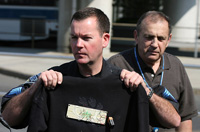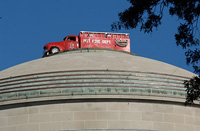The Biggest Pranks in Geek History
by Laura Fitzpatrick
Time.com
November 24, 2008
 Harvard and Yale’s annual gridiron face-off on Nov. 22 is a big deal for more than one set of storied college rivals. In the decades-old prank-off between archrivals MIT and Caltech, disrupting “the Game” has long been a particular point of pride. It’s not their only pranking outlet, of course: tech students have been wreaking havoc wherever they can since at least 1875, when MIT pranksters sprinkled classroom floors with iodide of nitrogen, a mild contact explosive, so their classmates’ feet would set off little fireworks with every step. Today, MIT maintains an earmarked prank fund, supported by alumni donations, to help students keep the tradition alive “” and to help keep the MIT Hacks from getting out-hoaxed by Caltech’s Prank Club. The bicoastal competition is the geeky version of working things out on the football field, and the resulting pranks “” whether Harvard is involved or not “” have made for some of the best college lore there is.
Harvard and Yale’s annual gridiron face-off on Nov. 22 is a big deal for more than one set of storied college rivals. In the decades-old prank-off between archrivals MIT and Caltech, disrupting “the Game” has long been a particular point of pride. It’s not their only pranking outlet, of course: tech students have been wreaking havoc wherever they can since at least 1875, when MIT pranksters sprinkled classroom floors with iodide of nitrogen, a mild contact explosive, so their classmates’ feet would set off little fireworks with every step. Today, MIT maintains an earmarked prank fund, supported by alumni donations, to help students keep the tradition alive “” and to help keep the MIT Hacks from getting out-hoaxed by Caltech’s Prank Club. The bicoastal competition is the geeky version of working things out on the football field, and the resulting pranks “” whether Harvard is involved or not “” have made for some of the best college lore there is.

The Great Rose Bowl Hoax: Spectators at the 1961 Rose Bowl game between the Minnesota Golden Gophers and the Washington Huskies received instructions: at halftime, those on the Washington side should take colored flip-cards off their seats and hold them above their heads, producing fifteen gigantic images one after another for the millions of fans watching on TV. One was meant to spell “Huskies,” another to reveal a picture of said dog. But when the crowd got in position for the fourteenth image, the thousands of placards spelled out a surprise: “Caltech.” The stunt left the television announcers speechless, and the band, taken aback, stopped playing. Weeks later, the students responsible “” known as the “Fiendish Fourteen” “” revealed their method: One of them had posed as a reporter, asking the head Washington cheerleader to detail the flip-card system. Then the students infiltrated the Washington cheerleaders’ hotel rooms and switched instruction sheets. (More recently, at the Harvard-Yale game in 2004, Yale students posing as the “Harvard Pep Squad” handed out placards so that at halftime, their rivals spelled out the message: “We Suck.”)
 A Different Kind of Cookie Monster: In 1970, unsuspecting MIT students working on a computer in one of the dorms had their work interrupted by the word “cookie” flashing across the screen. Unless the user responded right away, the flashing would speed up: “Cookie, cookie, give me a cookie.” After a few minutes “” presumably as the student was panicking that his or her work would be lost forever “” the peculiar program (patterned not after the character from Sesame Street, which was barely on air at the time, but after a cartoon “cookie bear” featured in a ubiquitous cereal commercial of the late 1960s) would flash the message, “I didn’t want a cookie anyway,” and disappear. Prior to that point, the only way to stop the onslaught was to type “cookie,” at which point the computer would flash “thank you” and desist. Some computer experts speculate that MIT’s “Cookie Monster” program, created by a few students during a school vacation, was the world’s first computer virus.
A Different Kind of Cookie Monster: In 1970, unsuspecting MIT students working on a computer in one of the dorms had their work interrupted by the word “cookie” flashing across the screen. Unless the user responded right away, the flashing would speed up: “Cookie, cookie, give me a cookie.” After a few minutes “” presumably as the student was panicking that his or her work would be lost forever “” the peculiar program (patterned not after the character from Sesame Street, which was barely on air at the time, but after a cartoon “cookie bear” featured in a ubiquitous cereal commercial of the late 1960s) would flash the message, “I didn’t want a cookie anyway,” and disappear. Prior to that point, the only way to stop the onslaught was to type “cookie,” at which point the computer would flash “thank you” and desist. Some computer experts speculate that MIT’s “Cookie Monster” program, created by a few students during a school vacation, was the world’s first computer virus.
 Hacking Harvard: For MIT hackers, wreaking havoc at the annual Harvard-Yale football game is a point of pride. In 1982, during a timeout, a group of MIT students launched an enormous weather balloon from beneath the turf at the 46-yard line, using a remote triggering system. After hanging in the air for a few moments so the crowd got a good look at the letters “MIT,” the balloon eventually exploded. Eight years later, a new generation of hackers tried to repeat their predecessors’ success: during the 1990 Harvard-Yale game, as a kicker prepared for a field goal, a rocket at the goal line exploded out of the ground, shooting a blanket-sized banner emblazoned with the words “MIT.” The rocket was launched using 480 feet of wire that ran underneath the field. A headline the next day in the Boston Herald read, “MIT 1 “” Harvard-Yale 0; Tech Pranksters Steal the Show.”
Hacking Harvard: For MIT hackers, wreaking havoc at the annual Harvard-Yale football game is a point of pride. In 1982, during a timeout, a group of MIT students launched an enormous weather balloon from beneath the turf at the 46-yard line, using a remote triggering system. After hanging in the air for a few moments so the crowd got a good look at the letters “MIT,” the balloon eventually exploded. Eight years later, a new generation of hackers tried to repeat their predecessors’ success: during the 1990 Harvard-Yale game, as a kicker prepared for a field goal, a rocket at the goal line exploded out of the ground, shooting a blanket-sized banner emblazoned with the words “MIT.” The rocket was launched using 480 feet of wire that ran underneath the field. A headline the next day in the Boston Herald read, “MIT 1 “” Harvard-Yale 0; Tech Pranksters Steal the Show.”
 Bargain-Basement University: On April 1, 1998, visitors to MIT’s website were informed that the university had been sold to Disney World for $6.9 billion “” the work of student hackers. MIT’s response? In a press release, a university spokesperson said he could tell it was a hoax as soon as he saw the alleged sale price. “Only $6.9 billion?” he scoffed. “Much too cheap!”
Bargain-Basement University: On April 1, 1998, visitors to MIT’s website were informed that the university had been sold to Disney World for $6.9 billion “” the work of student hackers. MIT’s response? In a press release, a university spokesperson said he could tell it was a hoax as soon as he saw the alleged sale price. “Only $6.9 billion?” he scoffed. “Much too cheap!”
 DVD Democracy: Two MIT programmers in 2000 decided they’d had enough with DVDs that would play on Macs or Windows PCs but not on the Linux operating system. By writing just seven lines of code, they created a program that could unscramble DVDs so they could be played on any operating system. They posted the code online, in part to help Linux users veg out with their laptops, but also as an exercise of free speech. The movie industry didn’t see it that way, however. Concerned about losing revenue if the code aided piracy, the Motion Picture Association of America threatened legal action, but ultimately decided not to sue.
DVD Democracy: Two MIT programmers in 2000 decided they’d had enough with DVDs that would play on Macs or Windows PCs but not on the Linux operating system. By writing just seven lines of code, they created a program that could unscramble DVDs so they could be played on any operating system. They posted the code online, in part to help Linux users veg out with their laptops, but also as an exercise of free speech. The movie industry didn’t see it that way, however. Concerned about losing revenue if the code aided piracy, the Motion Picture Association of America threatened legal action, but ultimately decided not to sue.
 Nerd Humor Meets California Landmark: During Hollywood’s centennial in 2003, Caltech’s Prank Club tackled the famous Hollywood sign with cherry pickers, large sheets of black and white plastic, and duct tape. They hung just enough plastic so that from a distance, the sign appeared to read “Caltech.” “Hollywood is still mad about that,” says Autumn Looijen, author of the prank history, Legends of Caltech III: Techer In the Dark. The sign assailants’ names never surfaced, but their work has become famous on campus. (Both Caltech and MIT tout their students’ pranks on their admissions websites.)
Nerd Humor Meets California Landmark: During Hollywood’s centennial in 2003, Caltech’s Prank Club tackled the famous Hollywood sign with cherry pickers, large sheets of black and white plastic, and duct tape. They hung just enough plastic so that from a distance, the sign appeared to read “Caltech.” “Hollywood is still mad about that,” says Autumn Looijen, author of the prank history, Legends of Caltech III: Techer In the Dark. The sign assailants’ names never surfaced, but their work has become famous on campus. (Both Caltech and MIT tout their students’ pranks on their admissions websites.)
 Lost in Translation: In 2005, three MIT graduate students skeptical of the standards at some academic conferences wrote a computer program to randomly generate papers, complete with charts and diagrams. They mad-libbed academic jargon “” which can sound like gibberish “” into sentences that literally were gibberish, such as, “The model for our heuristic consists of four independent components: simulated annealing, active networks, flexible modalities, and the study of reinforcement learning.” They even included fictitious citations. The students submitted two of the papers to the World Multi-Conference on Systemics, Cybernetics and Informantics “” and one of them was accepted. Conference organizers, who insisted the paper was one of a small number approved without being reviewed first, subsequently revised their acceptance procedures.
Lost in Translation: In 2005, three MIT graduate students skeptical of the standards at some academic conferences wrote a computer program to randomly generate papers, complete with charts and diagrams. They mad-libbed academic jargon “” which can sound like gibberish “” into sentences that literally were gibberish, such as, “The model for our heuristic consists of four independent components: simulated annealing, active networks, flexible modalities, and the study of reinforcement learning.” They even included fictitious citations. The students submitted two of the papers to the World Multi-Conference on Systemics, Cybernetics and Informantics “” and one of them was accepted. Conference organizers, who insisted the paper was one of a small number approved without being reviewed first, subsequently revised their acceptance procedures.
 Terrorist or Techie? In 2007, authorities arrested an MIT student at gunpoint in Boston’s Logan International Airport. Her crime? In truth, it was one for the fashion police: while holding five to six ounces of Play-Doh in her hands, the sophomore, as secretary of the MIT Electrical Research Society, arrived at the airport wearing a black sweatshirt decorated with a battery-powered circuit board that lit up to reveal the phrase “Socket to Me.” To authorities, the contraption looked like a bomb “” and the Play-Doh like plastic explosives. The student, who was charged with possessing a hoax device, claimed she had no such thing in mind: she was going to the airport to meet her boyfriend. And as for the outfit, it was career day at MIT, she said, and she just wanted to stand out.
Terrorist or Techie? In 2007, authorities arrested an MIT student at gunpoint in Boston’s Logan International Airport. Her crime? In truth, it was one for the fashion police: while holding five to six ounces of Play-Doh in her hands, the sophomore, as secretary of the MIT Electrical Research Society, arrived at the airport wearing a black sweatshirt decorated with a battery-powered circuit board that lit up to reveal the phrase “Socket to Me.” To authorities, the contraption looked like a bomb “” and the Play-Doh like plastic explosives. The student, who was charged with possessing a hoax device, claimed she had no such thing in mind: she was going to the airport to meet her boyfriend. And as for the outfit, it was career day at MIT, she said, and she just wanted to stand out.
 If at All Possible, Involve a Cow: MIT’s Great Dome is a prime hacking target since it graces all of the school’s admissions brochures. Students often scale the 150-ft. high building and deposit an object on the rounded roof, including a working phone both, a fake cow, a piano, a small house, and a police car, tagged with a parking ticket reading “No permit for this location.” Other pranks have taken advantage of the dome’s shape. One year, students topped the dome with a propeller, then added a red cloth stripe down the side so the dome resembled a giant beanie. Another year, students topped the dome off with an enormous pink nipple so it looked like a giant breast. And for the 1999 release of Star Wars: The Phantom Menace, students used colored fabric panels and black paint to make the dome look like R2-D2. Brilliant.
If at All Possible, Involve a Cow: MIT’s Great Dome is a prime hacking target since it graces all of the school’s admissions brochures. Students often scale the 150-ft. high building and deposit an object on the rounded roof, including a working phone both, a fake cow, a piano, a small house, and a police car, tagged with a parking ticket reading “No permit for this location.” Other pranks have taken advantage of the dome’s shape. One year, students topped the dome with a propeller, then added a red cloth stripe down the side so the dome resembled a giant beanie. Another year, students topped the dome off with an enormous pink nipple so it looked like a giant breast. And for the 1999 release of Star Wars: The Phantom Menace, students used colored fabric panels and black paint to make the dome look like R2-D2. Brilliant.
images: Geek crossing: Andrea Mercado; Cookie monster: Everett; Disneyland: Joe Raedle / Getty; Lost in translation: iStock Photo; Terrorist or Techie: Mike Adaskaveg / Polaris; Involve a cow: Donna Coveney / MIT News Office / AP
